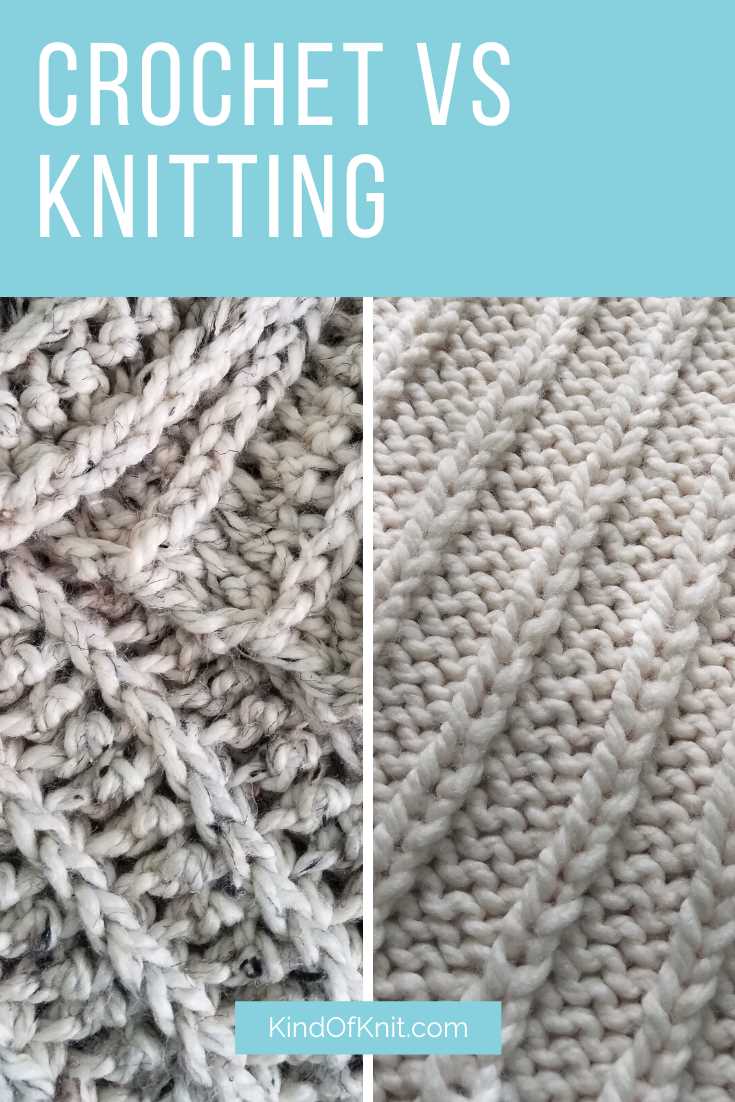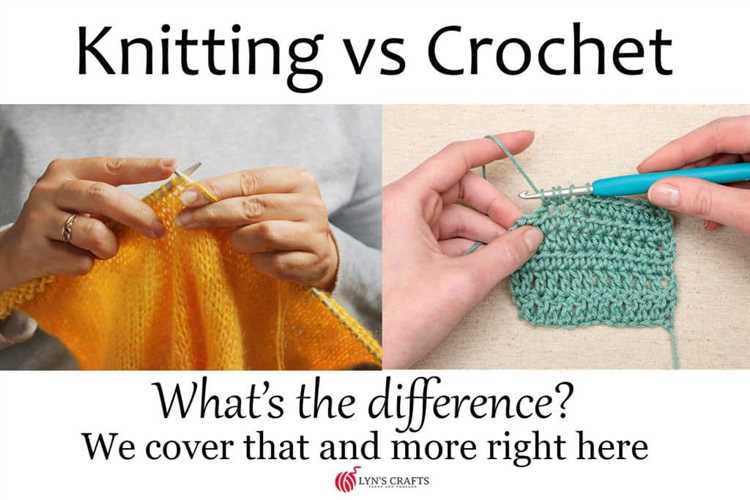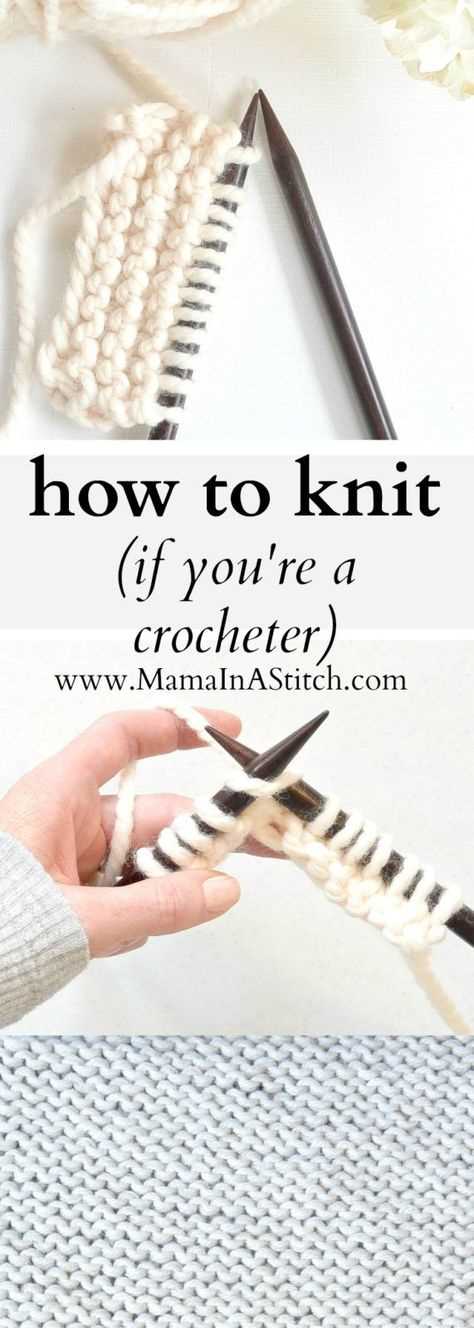Knitting and crochet are both popular crafts that can be used to create beautiful and functional items. Many people are drawn to these crafts for their therapeutic benefits and the satisfaction that comes from creating something with their own hands. However, if you’re new to the world of yarn crafts, you may be wondering which one is easier to learn: knitting or crochet. In this article, we’ll explore the differences between knitting and crochet, and help you determine which craft is a better fit for you.
Knitting involves working with two pointed needles while creating intricate stitches. It’s a technique that requires both hands, as one needle holds the stitches while the other manipulates the yarn. Knitting can be a bit more challenging to learn initially, as there are many different types of stitches and techniques to master. However, once you become comfortable with the basics, knitting can be a relaxing and enjoyable craft.
Crochet, on the other hand, uses a single hook to create a variety of stitches. Unlike knitting, crochet only requires one hand to hold the hook, while the other hand controls the tension of the yarn. This makes crochet a bit easier to learn for beginners, as there are fewer techniques and stitches to learn. Crochet is also often considered a faster craft, as the stitches are generally larger and take up more space.
In conclusion, whether knitting or crochet is easier will depend on your personal preferences and learning style. If you enjoy intricate details and working with smaller stitches, knitting may be a better fit for you. On the other hand, if you prefer larger stitches and a faster pace, crochet may be the craft for you. The best way to determine which craft is easier for you is to give both a try and see which one you enjoy more. Whichever craft you choose, both knitting and crochet offer endless possibilities for creativity and self-expression.
Is Knitting or Crochet Easier?
When it comes to deciding whether knitting or crochet is easier, it ultimately depends on personal preference and learning style. Both crafts have their own unique techniques and learning curves, but some people may find one to be easier than the other.
Knitting:
- Uses two knitting needles to create stitches
- Requires the use of both hands
- Generally involves working on fewer stitches at a time
- Provides a structured and uniform fabric
- Uses techniques such as knitting, purling, increasing, and decreasing
- May take longer to learn initially
Crochet:
- Uses a single crochet hook to create stitches
- Only requires the use of one hand
- Allows for more versatile stitch patterns
- Can create a more textured and flexible fabric
- Uses techniques such as single crochet, double crochet, and treble crochet
- May be easier to learn for visual learners or those who prefer working with one hand
In the end, both knitting and crochet can be enjoyable and rewarding crafts to learn. It’s best to try out both and see which one feels more intuitive and comfortable for you. Some people may find knitting easier due to its structured nature, while others may prefer crochet for its versatility and ease of use with one hand.
Regardless of which craft you choose, with practice and patience, you can become proficient in knitting or crochet and create beautiful handmade creations.
Benefits of Knitting
Knitting is a popular craft that comes with several benefits for those who practice it. Whether you are an experienced knitter or just starting out, here are some of the advantages that knitting can bring:
- Stress Relief: Knitting has been proven to have a calming effect on the mind and body. The repetitive motions and focus required while knitting can help reduce stress and anxiety.
- Creativity Outlet: Knitting allows you to unleash your creativity by choosing different yarns, patterns, and colors. You can create unique and personalized items, from scarves and hats to blankets and sweaters.
- Mental Stimulation: Knitting requires concentration and focus, which can help keep your brain engaged and improve cognitive function. It can also improve hand-eye coordination and fine motor skills.
- Social Connection: Knitting is often done in groups, whether it’s joining a knitting club or attending knitting classes. This provides an opportunity to meet new people, share ideas, and learn from others.
- Portable and Convenient: Knitting is a portable craft that can be taken anywhere. Whether you’re traveling or waiting for an appointment, you can easily bring your knitting project along and make progress.
- Sustainable and Eco-Friendly: Knitting encourages the use of natural fibers and sustainable yarns, reducing the reliance on synthetic materials. It promotes a more environmentally-friendly approach to fashion and reduces waste.
- Therapeutic Benefits: Knitting has been found to have therapeutic benefits for individuals with conditions such as arthritis, dementia, and depression. It can provide a sense of accomplishment and purpose.
Overall, knitting offers a wide range of benefits beyond just creating beautiful handmade items. It can improve your mental well-being, allow you to express your creativity, and connect you with a community of like-minded individuals. So why not give knitting a try?
Benefits of Crochet
Crochet is a popular craft that offers a variety of benefits. Whether you’re a beginner or an experienced crafter, here are a few reasons why crochet might be the right fit for you:
- Portability: Crochet projects are typically smaller and more portable than knitting projects. You can easily take your crochet hooks and yarn with you wherever you go, making it a great choice for crafting on the go.
- Quick Projects: Crochet stitches tend to be larger and bulkier than knitting stitches, which means projects can be completed more quickly. If you’re looking for instant gratification, crochet may be the way to go.
- Versatility: Crochet offers a wide range of stitches and techniques, allowing you to create intricate patterns, textures, and shapes. It’s a versatile craft that allows you to experiment with different designs and techniques.
- Less Equipment: When it comes to crochet, you only need a crochet hook and yarn to get started. There are no additional tools or needles required, making it a more accessible craft for beginners.
- Great for Beginners: If you’re new to the world of crafting, crochet can be an easier skill to learn compared to knitting. The basic crochet stitches are relatively simple and can be mastered quickly.
Whether you’re looking to create cozy blankets, stylish accessories, or intricate lacework, crochet offers a range of benefits that make it a great choice for crafters of all skill levels.
Materials and Tools
Both knitting and crochet require specific materials and tools to create beautiful creations. Here’s a breakdown of what you’ll need for each craft:
Knitting:
- Yarn: Knitting requires yarn, which comes in various colors, textures, and weights. The type of yarn you choose depends on the project you’re working on.
- Knitting Needles: Knitting needles come in different sizes and materials, such as metal, wood, or plastic. The size of the needles determines the gauge or tension of your stitches.
- Measuring Tape: Measuring tape is essential for ensuring the correct dimensions of your knitted item.
- Scissors: Scissors are needed for cutting the yarn and finishing off your project.
- Tapestry Needle: Also known as a yarn needle, a tapestry needle is used for seaming and weaving in loose ends.
- Stitch Markers: Stitch markers help keep track of specific stitches or pattern repeats.
Crochet:
- Yarn: Crochet also requires yarn, which comes in a variety of colors and textures.
- Crochet Hooks: Crochet hooks come in different sizes and materials, similar to knitting needles. The size of the hook determines the gauge or tension of your stitches.
- Measuring Tape: Measuring tape is crucial for ensuring the correct dimensions of your crocheted item.
- Scissors: Scissors are necessary for cutting the yarn and finishing off your project.
- Tapestry Needle: A tapestry needle is used for weaving in loose ends and seaming.
- Stitch Markers: Like in knitting, stitch markers are helpful for keeping track of specific stitches or pattern repeats.
Overall, the materials and tools needed for both knitting and crochet are similar, but the main difference lies in the type of needles or hooks used. Both crafts offer a wide range of options for yarn and other accessories, allowing you to experiment and find what works best for you.
Learning Curve
When it comes to the learning curve, both knitting and crochet have their own challenges. However, many people find crochet to be easier to learn initially.
Crocheting involves using a single hook to create stitches, while knitting requires two knitting needles. This makes it easier to handle the yarn and manipulate the stitches when crocheting.
In crochet, there are fewer types of stitches to learn compared to knitting. Crochet mainly involves mastering basic stitches such as chain, single crochet, double crochet, and treble crochet. Once you have a grasp of these basic stitches, you can create a wide variety of projects.
Knitting, on the other hand, has a wider range of stitches to learn, including knit, purl, stockinette, ribbing, lace, and cable stitches. Some stitches require both knitting and purling in a specific pattern, which can be more challenging for beginners.
However, once you become more proficient in either knitting or crochet, the learning curve levels out. With practice, you can become skilled in either craft.
It’s also worth noting that different people have different preferences and learning styles. Some people may find knitting easier to grasp, while others may find crochet more intuitive. It ultimately depends on your individual learning style and preferences.
Overall, both knitting and crochet have their own learning curves, but many beginners find crochet to be easier to pick up initially due to its simpler stitches and fewer tools required.
Projects and Applications
Both knitting and crochet offer a wide range of projects and applications that cater to different interests and preferences. Here are some popular examples:
Knitting Projects
- Sweaters: Knitting allows for precise stitch patterns, making it a great choice for creating cozy and stylish sweaters.
- Hats and scarves: Knitting can produce intricate patterns and textures, making it ideal for designing hats and scarves with unique details.
- Socks: Knitting allows for a perfect fit when creating socks, and the fabric is usually durable and comfortable.
- Blankets and afghans: Knitting can create intricate and soft fabrics suitable for large projects like blankets and afghans.
Crochet Projects
- Amigurumi: Crochet is often used to create adorable stuffed animals and toys known as amigurumi. The single crochet stitch is used extensively in these projects.
- Home Decor: Crocheted home decor items like doilies, table runners, and pillow covers add a touch of elegance to any space.
- Granny squares: Crochet is known for its ability to create colorful and intricate granny squares, which can be joined together to make beautiful blankets, shawls, and garments.
- Accessories: Crochet lends itself well to making accessories like bags, headbands, and jewelry.
Applications
Both knitting and crochet can be utilized in various practical and creative applications:
- Fashion: Both crafts can be used to create fashionable garments and accessories.
- Home textiles: Knitting and crochet can be applied to create cozy and decorative items for the home.
- Gifts: Handmade knitted or crocheted items make thoughtful and personalized gifts for friends and family.
- Therapeutic purposes: The repetitive motions of knitting or crochet can be relaxing and provide stress relief.
Ultimately, the choice between knitting and crochet depends on your personal preferences and the types of projects you enjoy. Both crafts offer endless possibilities for creativity and self-expression, so pick the one that speaks to you and start creating!
Community and Resources
Both knitting and crochet have strong and supportive communities of crafters who are eager to help beginners and share their knowledge. Joining a crafting community can be a great way to learn and improve your skills, as well as find inspiration and motivation.
There are numerous online platforms and forums dedicated to knitting and crochet, where crafters can connect, share patterns, ask questions, and showcase their projects. These communities often have groups or threads specifically for beginners, making it easier for newcomers to get started and receive guidance.
In addition to online communities, many cities and towns have knitting and crochet groups that meet regularly. These groups provide an opportunity to meet fellow crafters in person, learn from each other, and work on projects together. Local yarn shops may also offer classes and workshops for beginners.
Another valuable resource for both knitting and crochet enthusiasts is books and tutorials. There are countless books and instructional videos available that can guide beginners through the basics and provide inspiration for more advanced projects. Libraries and online platforms such as YouTube and Craftsy offer a wide range of free and paid resources.
When starting out, it can be helpful to have a few essential tools and materials. For knitting, you’ll need knitting needles and yarn, while crochet requires a crochet hook and yarn. Local yarn shops and craft stores usually carry a variety of materials suitable for beginners.
Overall, both knitting and crochet offer rich communities and abundant resources for beginners. Whether you prefer to learn online or in person, there are plenty of options available to help you get started on your crafting journey!
Which Craft is Right for You?
Choosing between knitting and crochet can be a difficult decision. Each craft has its own unique advantages and appeal. Here are some factors to consider when determining which craft is right for you:
Skill Level
If you’re new to needlework, you may find crochet to be easier to pick up. Crochet stitches are typically larger and can be easier to see and manipulate. Knitting, on the other hand, often requires more dexterity and control.
Speed
If you want to create projects quickly, knitting can be faster than crochet. This is because knitting typically requires fewer stitches per inch than crochet, allowing you to complete projects more quickly.
Texture
If you love creating intricate textures, crochet may be the craft for you. Crochet allows for more variation in stitch patterns, creating beautiful textured fabrics. Knitting, on the other hand, tends to create smoother and more uniform fabrics.
Portability
If you’re looking for a craft that you can take with you on the go, both knitting and crochet can be portable. However, crochet projects typically require just one hook, making them easier to carry and work on in small spaces.
Versatility
Both knitting and crochet offer endless possibilities for creativity. However, crochet is often seen as more versatile due to the variety of stitches and techniques that can be used. Knitting is known for its beautiful, intricate patterns, but can be more limited in terms of stitch options.
Final Decision
Ultimately, the right craft for you depends on your personal preferences and interests. If you enjoy intricate textures and portability, crochet may be the better choice. If you prefer smoother fabrics and speed, knitting may be more suited to your tastes. It may be helpful to try both crafts and see which one you enjoy more before making a final decision.
FAQ:
Which is easier: knitting or crochet?
Both knitting and crochet have their own learning curves, so it ultimately depends on the individual. Some people find knitting easier because there are fewer stitches to learn and it can be easier to fix mistakes. Others find crochet easier because the stitches are typically larger and it can be easier to see and correct errors.
What are the main differences between knitting and crochet?
The main difference between knitting and crochet is the tools and techniques used. Knitting uses two pointed needles to create stitches, while crochet uses a single hook. Knitting generally creates a more even and structured fabric, while crochet allows for more versatility and creativity in stitch patterns.
Which is faster: knitting or crochet?
It depends on the individual and the project. Knitting tends to be faster for creating structured garments like sweaters, while crochet can be faster for creating larger, looser items like blankets. Ultimately, the speed of both crafts comes down to practice and individual skill.
Is it difficult to learn knitting or crochet?
Learning knitting or crochet can be challenging at first, but with practice and patience, anyone can learn these crafts. There are many resources available, such as online tutorials and classes, that can help beginners get started and improve their skills.
What are some popular projects for knitting and crochet?
There are countless popular projects for both knitting and crochet. Some common knitting projects include scarves, hats, and socks, while common crochet projects include blankets, amigurumi toys, and shawls. The possibilities are endless and depend on the individual’s interests and preferences.
Can I knit and crochet together in one project?
Absolutely! Many crafters enjoy combining both knitting and crochet techniques in their projects. For example, you could knit a sweater and then crochet a decorative border. The combination of knitting and crochet can add unique texture and design elements to your creations.


